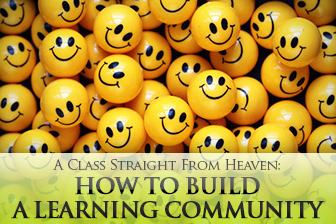Great Development, but Work on Your Transitions: Peer Review Groups to Improve Analytical Reading and Writing


If they don’t, another classmate will help without being asked. They share information with each other freely. They form groups easily without being prodded and assume roles within the group without being told what to do. In such a classroom, students also typically, when they get papers back, check their answers and grades against their peers’ or discuss them with the teacher without too much drama and a seeming focus on the work itself, not the grade. They share their experiences with the teacher and classmates, who seem genuinely interested.
So this may seem like a class straight from heaven, created more from divine, rather than teacher, intervention. On the contrary, however, it reflects the teacher’s careful craftsmanship over the term to create a learning community, a community in which everyone teaches and learns in an environment that is safe for making mistakes.

To achieve a strong learning community, teachers must have a vision of the kind of class they want: students working, learning, and teaching in harmony. However, we can’t act in the long-term; we can really only act in the short term and in small incremental steps of first getting students used to working in groups, teaching procedures for group work, and developing a safe environment, and so forth. However, the vision will collapse if not put into practice in a series of small steps in the present.
The first step in developing a learning community is in getting students used to the entire notion of community, which implies a group, rather than individual process. So the first couple of weeks should be devoted to having students work in various groupings in which they share ideas on a reading, for example, and begin to learn polite ways to advance an opinion or disagree with another person’s.
Because students are working in groups, they need to learn some of the logistics of group work, such as how to select group members, how to divide up roles of leader, recorder, and materials gatherer, and how to get in and out of groups with minimal disruption. The teacher may have to take a couple of weeks teaching these procedures before students will be able to practice them on their own. It is very rewarding when students go from not quite knowing what to do at the beginning of the semester to coming into class, finding partners, setting up their groups, and getting to work with minimal assistance from the teacher. This is the beginning of the learning community, when students are able to function in a group, but it is not quite developed yet—students may be functioning, but for it to be a true learning community, they must thrive.
A safe environment is also very important to a true learning community. This is an environment where the students feel free to share ideas without being ridiculed—questioned, certainly, but in a respectful manner. This can be achieved by discussing the elements of a safe learning environment, perhaps developing with the students the “rules of engagement,” as I call them, for working in groups. The teacher should also always model respectful, attentive behavior when students are speaking. Even if the student is not particularly polite—interrupting a lecture, for example, to talk off topic—the teacher remaining calm and courteous sends a powerful message of how students should treat each other. Once a safe environment is achieved, the foundation for a learning community is laid.
For a learning community to thrive, there must a focus on the collective—a community is a collective, after all. However, the individual student’s needs and contributions within that community must also be recognized, or the community dies, as it is made up of individuals.
So there must be a balance in focusing not only on group processes and work but also on the individual contributions within that group. This can be done by rewarding both group and individual efforts, providing opportunities for individual students to present before the class as well as in groups, and recognizing both individual ideas and work and group processes and endeavors.
Finally, students should be allowed as both individuals and group members to showcase the expertise. For example, individual students can demonstrate their expertise all semester long, in class sessions devoted to individual students teaching their peers content they are experts in—how to plant and tend a garden, for example, or how to repair a bicycle. As a group students will also teach other groups their particular interpretation of a reading, for example, or the recommendations they have crafted on some social issue like same-sex marriage. The teacher also becomes a learner here as he learns about students’ areas of expertise and perspectives. It is at this time the learning community is really formed because at this point everyone is a learner and everyone is a teacher.
It requires careful planning and craft on the part of the instructor and engagement on the part of the students. However, by starting small, teaching students the process of a learning community through group work, and creating a safe environment for everyone to thrive, a true learning community, where everyone teaches and learns, can be achieved.
What are your thoughts on the value of learning communities? What are your methods for establishing them?